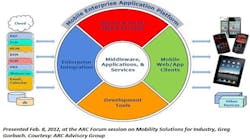Mobility in manufacturing used to mean talking through handheld radios and then entering data into applications designed for desktop environments. Simple, but time consuming, error-prone and inefficient.
Industry studies estimate that 10 percent of mobile users today are in the factory and on the construction site – and that number continues to grow. This is causing some manufacturers to ditch the old way and drive mobility in operations with IP-enabled devices. And they’re doing it by leveraging consumer and commercial devices and technologies in industrial environments.
Devices such as video cameras, RFID readers, digital tablets, and security swipe-cards are open-standard, IP-enabled devices that can be repurposed in manufacturing to help you leverage your workforces demand of mobility. However, deploying these devices in industrial settings requires some forethought. Consider three steps before integrating these devices into your current information architectures.
Focus on Security
Operational data is a key business asset, one which is only as secure as the devices which have access to the data sets. Mobile device management (MDM) is the ability to restrict access, enforce security policies, and monitor mobile access to company assets such as email, portal sites, and mobile applications. By controlling and protecting the data and configuration settings for all mobile devices in the network, whether internally supported or covered under a BYOD plan (i.e., Bring Your Own Device), MDM can greatly reduce business risk and support costs. Use acceptable security policies and best practices from the IT environment and standards organizations like ISA-99.
Define your rollout plan. A mobile device is just that – a device. It’s only valuable if you consider where and how it’s used. Whether it’s the C-suite, IT, facilities or production, you need to identify which business processes and workflows would benefit from the anytime/anywhere access to data that mobile devices can provide, and then work with a core stakeholder team to build the rollout plan and identify any associated application development projects. And don’t forget to involve IT. They’ll have an important voice in determining what applications and devices will be supported, and at what cost.
Plan for change. Unlike your traditional automation controller environments, which stay relatively unchanged for years on end, the device and system advancements in today’s mobile environment have much briefer life cycles – in some cases less than two years, especially if the device is being used in a
harsh environment. Plan for a mobile environment that is flexible enough to change and update endpoint devices, sensors, and applications without a complete system redesign and overhaul.
At Owens Corning, for example, mobile devices in the manufacturing environment include tablet-based tracking of key performance indicators (KPI) to keep information flowing to operators and other key production stakeholders, including the management team. Using tablet devices, workers incorporate daily production KPIs and efficiency metrics to help production teams optimize plant performance.
Porting even mission-critical applications onto smartphones and media tablets is becoming more commonplace as improving mobility of your workforce and your information can lead to great productivity gains. Hopefully these three considerations will keep you on the right path and away from potholes and barriers.
What are some of the potholes or best practices you’ve experienced in your road to mobility nirvana?



